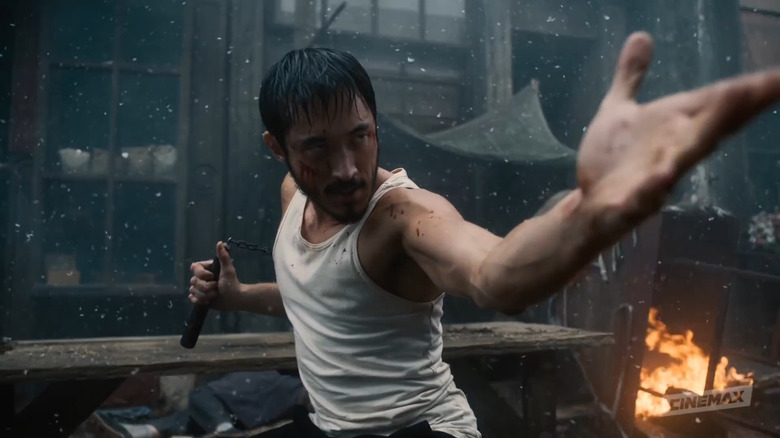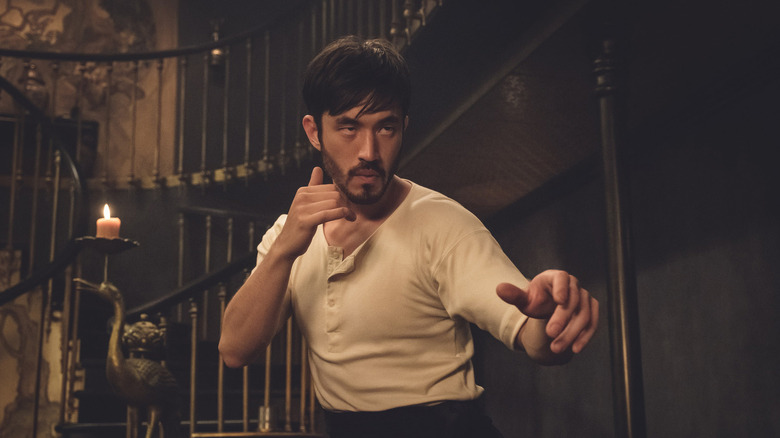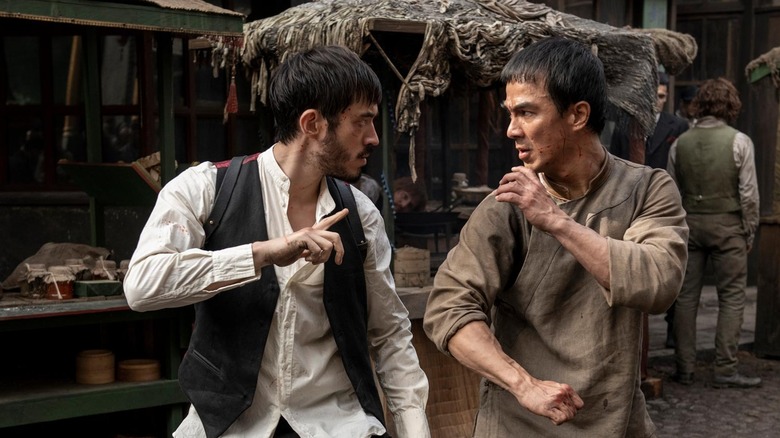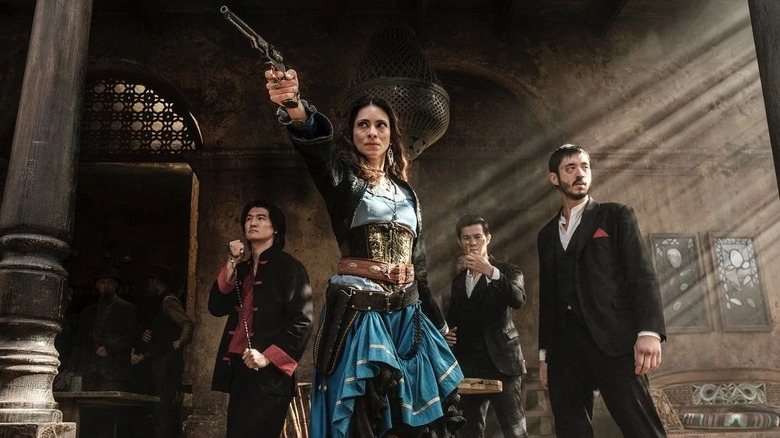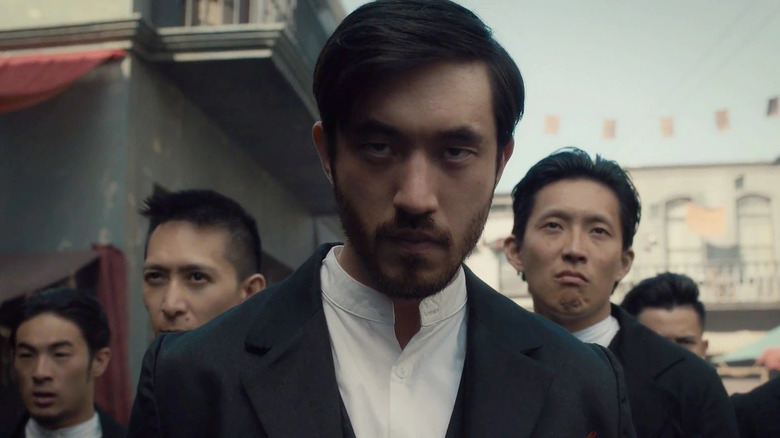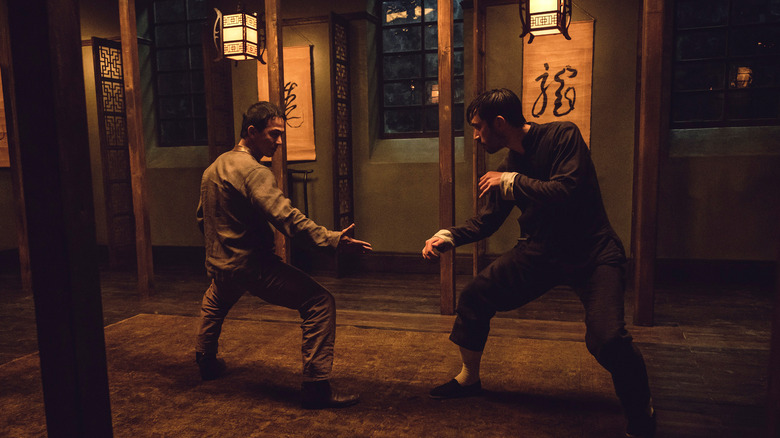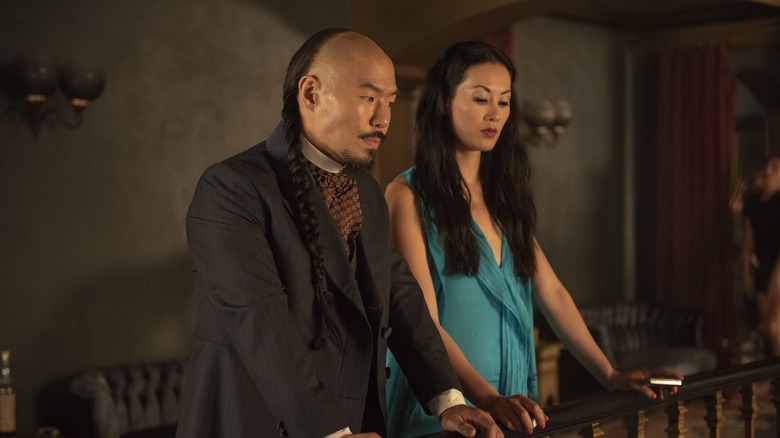Warrior Stunt Coordinator Brett Chan On How You Craft A Great Action Scene [Interview]
"Warrior," based on the writings of Bruce Lee, has some of the strongest action on television. The Cinemax show, which gained well-deserved popularity once it hit HBO Max, is a powerful combination of action and drama. Sometimes it's fun, sometimes it's tragic — the period piece has its cake and eats it, too, striking the balance between heightened escapism and brutal reality. "We try and create that within everything," stunt coordinator Brett Chan told /Film in a recent interview. "Within the action there's drama, so that you're drawn into the characters and the fights. It's a part of the story as opposed to just to fight."
Fighting for the sake of fighting bores Chan.
The veteran stunt performer and coordinator, who was in Bulgaria working on Netflix's "Wednesday" when we talked to him, wants the action to tell a story greater than who wins or loses a fight. Chan not only coordinates the fights, but he often shoots them himself. During a conversation all about his work on the show, he took us behind-the-scenes of the series and shared his wisdom on how you craft a great action scene.
"He's fast enough to hit you from afar."
How do you want to define the characters through action?
I take into play their stature, like how big someone is, how thin someone is, and what they use, then you take their characters and their temperament. In season one, Bolo is like, "No bullsh*t." Basically, everything he hits he wants to break. Or Andrew Koji, Sahm, he's fast and he'll pelt you with everything and take you down that way. Every time you throw something at him, he'll break it so you can't use it again and then he'll just pepper you because he's so fast and he knows exactly where to hit. Because Joe Taslim has a judo background, he likes to grab and every time he grabs something, he breaks something. That's why you just don't want to get too close to him, but he's fast enough to hit you from afar.
Chen, which is Hong, plays with the chain. He doesn't necessarily have a martial arts background so he was learning about a month prior to that, on his own, and then when he came to training with us we developed him a bit. Like Jason Tobin, after season one, he went and did more martial arts. But because we want to differentiate everybody, James' thing was basically knives. He wasn't a kicker or a puncher. He'd throw a kick every once in a while but it wasn't a very nice-looking kick.
They can all fight the same way. Let's say Joe and Bolo and Sahm all train in the same school from the same age, the same amount of training, same style, everything like that, but they're going to execute each loop differently. Let's say you and I trained in the same place, but you throw a punch and I'll throw a punch, but because we're built very differently, we'll try and execute power differently. So then we'll throw the exact same move but it'll look completely different because of where you generate your power and where I generate my power. And then our personalities come into play, how we want to inflict this pain on people and then the mood that we're in.
The fight at the end of season two between Ah Sahm and Dylan Leary is a great illustration of that. You see how their moods affect their fighting.
That was kind of foreshadowing because I did that in season one, episode 10, when Dean [Jagger] shows up and they have maybe eight to 10 beats with each other, but Dean was supposed to be the freight train. So even as Dean was coming in at him and Andrew was hitting him the whole time, he wasn't stopping, he was just coming straight in and still. And then Andrew, he switched around.
I think it was episode six when they're standing outside the coal mine or the steel factory, and Dean's like, "Yeah. You Chinese, you come and take our jobs," and he stops and goes, "Do I look like I want your fucking job? Look how I'm dressed. Look how you're dressed." So that moment was just tension building, it was so good, and then of course it carried on to the end.
"There's no mercy here."
You feel every blow of those fights. What's the challenge for you preparing those one-on-one fights?
Well, that was particularly difficult because we were block-shooting, so we were shooting four episodes at once. I was choreographing for seven, eight, nine, which is the raid, the riots. And within the riot itself, that alone had 11 fights. 11 fights happening, as well as the choreographing the end fight, as well as I'm training both of them, as well as the fight with Ah Toy. Well, 12 fights, with the two fighting inside the brothel. So, that was particularly hard.
Whenever I try to get into these fights, they're writing these fights already but they're not martial artists. [Showrunner] Jonathan Tropper is a martial artist and he'll write the fights out and he'll say, "Brett, I know you're going to do something different with this, but just keep these three or four points that I want to see within the fight itself." I say, "Okay, great." I go choreograph the fight, but before that I go talk to the actors and see where they're at at this moment because they could be exhausted.
Like in episode six, when they are fighting the drug dealer guys, it was a long oner shot how they shot it, they weren't trying to kill them. Jason Tobin is stabbing him in the foot, he's not stabbing him in the head. So there are fights that will change differently where when you watch them in the end battle, well, episode nine at least, they're out to kill. There's no mercy here.
But now you watch the fight with Dean and Andrew, Andrew's really tired. He's been in this world a whole day, but he's there to prove a point. He's not there to kill Dean. He's there to hurt him but not kill him, and I think it was more about humiliating him. He came there by himself, so we have to show the progression of tiredness after each blow hits. Because you watch all the fights where the guy's already hit like five or six times, seven times, eight times, and they're still fighting normally.
I love that about the show. They're incredibly capable, but there's still danger. They still get hurt.
And that's the actors. Even actors who don't have any action like Father Jun or Dianne and everybody, they're there every day. The actors are training with us every day, even when they're not supposed to be training. Half the time I got to kick them out like, "Get out. I got to do some stuff here." And they don't want to leave. "Can I just go hang out in this corner?" "Okay. Yeah, go ahead." I love that they love being around the stunt guys, they love being around the family that we create.
I have training sessions, 7:00 AM, and it's like two hours. It's a type of CrossFit, weight training, strengthening kind of thing. They train every day. And then after that, then we have another hour and a half training of different martial arts every day, because I want the guys to be as versatile as possible.
"Say if I threw a hook at you..."
You and Olivia Cheng worked together before on "Marco Polo." How do you work with someone on wielding a sword?
Yes, for "Warrior," Jonathan Tropper's idea for her was that she was a master when she has a sword. To be so proficient at sword you have to be a martial artist to some degree to be able to use a sword that way and have that kind of efficiency. I think it was episode eight, when she got almost killed?
Yes.
And so we didn't give her her sword at that moment for that very reason. These guys were particularly strong in what they did to her. Until the very end when the guy goes up to go get her and she's like, "No, no" and she pulls her sword. We see her sword and now it's over. She's just supposed to be efficient. She's efficient with the sword. One or two strikes and it's over, which is realistic. If you have someone that is efficient with a sword, you're going to be dead.
What rings phony to you when, say you're watching a movie or a show, and watch an action scene?
Say if I threw a hook at you and all you did was put your hand up, you're not going to block it. Unless you're moving with it, blocking and moving and absorbing, it's a little bit different. You got someone who's 200 pounds throwing this big haymaker on you and you're going to block it just by putting your hand up and then punch him back? You could say it makes for good happy moves and makes a fight look cool, if that's the style you're looking for...
A lot of stuff like Jason Statham, what he does is, it's not like that. You feel the impact of what he's doing, which is kind of cool, and you'll notice that with certain fights and with certain people. I don't like creating fights for the sake of just creating fights. I don't like, "Okay, we're going to put a fight here, but it's all a bunch of cool moves," which is not cool because then people get bored of watching the fights all the time that way.
"I have to let them know that's going to be unsafe."
Working with actors who are inexperienced, what are some tips or advice you give them on selling certain moves?
See, Olivia [Cheng] didn't have any martial arts experience. She's a gymnast, though, so she has good body control. Basically, what I do is I try to teach them first foot work. Once I get footwork down, it gives them one less thing to think about. If you're not a martial artist, you don't have good footwork, then every time you have to think about your step and you have to think about the arm, then you got to think about the look and you got to think about the other actor. But if your footwork is already solid, you know where it's going to go every single time. It's so much safer and they pick it up much faster.
It's a slower process because trying to teach them footwork, really hard at first, but once you get that, you set them up in an order of lessons, and they'll feel like, "I'm not learning much and this is just stupid." But once they get that and after X amount of time, they'll be like, "Oh, it's so much easier."
There's little room for faking it in this show. The editing lets you enjoy the action and choreography. How much does how a director intends on shooting a scene, like a long take or more aggressive cutting, influence you?
I was fortunate that Jonathan Tropper let me, after he saw me working on this one thing that wasn't working, I just said, "Just let me try, Jonathan." So I did it, which the one fight in the brothel in episode one. Jonathan said, "Oh, wow. Just do it Brett." So I know exactly how I'm going to shoot it when I choreograph it. I know the angles I want to do and where I want to take it and how I want it to play out. Once that happens, then I can previs it. And then you talk to the actors, where they want to be in certain things emotionally or what's happening, so then at that point then I know how I want to shoot it.
But if I don't know how I want to shoot, because a lot of times directors want to shoot themselves, regardless of whether they know how to shoot it, they just want to shoot themselves because they want to say they shot it, which is fair enough. They're helming the ship, it's fair enough. Okay, great so you kind of let them. What I'll do at that point is I'll create the fight and I'll write a shot list according to how I choreographed it and prevised it. Let's say there are 30 shots here, okay, well now the director wants to change this, this, this, this. Okay, so then I can remove shot 17, 21 and 14 and the fight will still work.
So at that point, that's the only saving grace I can do with a fight. It all depends if you want to shoot with actors or you want to shoot with doubles, because you shoot doubles there are always cuts everywhere. If you want to shoot long oners, the actors, then the actors have to be really good. If they're not, then the director is going to suffer. They got to cut it at some point because the actors won't be able to do it, and at that point, it becomes unsafe. I have to let them know that's going to be unsafe.
"It's got to be realistic."
Say for the season one finale where Mai Ling almost has her brother killed, for instance, how'd you collaborate with the director on that fight?
That was Loni Peristere. Loni Peristere is awesome. He pretty much just tells me the same thing, he goes, "Go do this, Brett. This is what I want to see, this is detailed out and I need this, this, this, this point in here." Loni is so fantastic at identifying his team and seeing who's good and then seeing who wants to do certain things. He'll let you run with it.
Loni is also the CEO of Zoic Studios, a visual effects company, so he knows where he needs certain things, and he also edits in his head. So as long as you give him this much and he says, "Okay, great. I can cut here. I can cut here. I'm going to move this one longer." Or, "Okay, can you make this one long?" I know exactly how to help the actors make that happen. Otherwise, it's going to be disjointed or it won't look good. I'll say, "This can be good longer oner here. You probably have to cut here." He shoots exactly that way, it's exactly what the previs is, but he lets me shoot it.
Lori will let me shoot all the action with the drama in it. Usually when I shoot stuff, I'll only shoot exactly the previs and I won't give them too much more because if I would give them too much more, the editors will take it and they're not there with the fight, they're not there with the accuracy, they're there with the story, so then what happens is they just end up cutting the wrong shot and it doesn't look good that way.
So I shoot exactly and I will give little variations to what it is, but keeping the same thing and then I'll go edit it myself with my right-hand man, Johnny. And then editors will get it and they'll piece it together, but they'll find that they can't actually edit it differently from what it is.
What are some pet peeves you have when watching action scenes?
For me, it's a big pet peeve when I'm watching a fight and there are multiple guys. If there are five guys and you're just fighting one of them at a time, that's a big pet peeve when I'm watching shows like that and that's what happens in the fight. That is just never going to happen. It's got to be realistic. It's going to be all of them coming at you, like two or three at a time, because not all five can be there because of spacing, but your guy should be dealing with multiple things at once.
That happens so much. You'll see guys just standing around.
All the time.
"We call it Bruce Leeisms."
For you, what's a gold standard in terms of action?
One of my favorite movies is "The Bourne Identity." In every fight, you'll see his intention in every movement and every time there are multiple opponents he's never ever just standing there. No one's ever standing there. Like when he's in the embassy, he's dealing with one, then the other guy comes up and then all three at the same time, and it all makes sense.
To wrap, what are some of the more subtle influences you take from Bruce Lee's fighting style?
Obviously this was written by Bruce Lee originally. It wasn't meant to be Bruce Lee but it's meant to be him playing it. So we call it Bruce Leeisms. Now, you can't really be Bruce Lee. No one can really be Bruce Lee. The guy's a legend. You can emulate him with certain things like how he moves, stands, and certain movements that he would do. But he's always talked about hybridism of martial arts, which gives rise to the greater good of things, not just single martial arts every single time.
So with Andrew, he didn't want to play Bruce Lee, but he definitely put Bruce Leeisms in it to give that portrayal. Jonathan Tropper, and Shannon Lee and Justin Lin, and Brad Kane, their head writer, they basically put homages to something that Bruce has done in one of his movies prior. It gives you that moment where you see Bruce Lee.
"Warrior" is currently streaming on HBO Max.
